Desperately Seeking Solitude
“I love tranquil solitude…” Shelley, the ill-starred poet, he of the golden pen, knew the true value of solitude. And so do we. All around, we see the vaunted worth of the priceless melt away. The most highly prized dwindles, fades into the commonplace. But solitude eludes the calipers of ordinary measure. Not easily found today. How much more difficult tomorrow? Solitude. Such a luxury. No, the new luxury. It’s the exclusive reserve of the wealthy…or the ingenious. Presented in these pages, still spared the encroachment of progress, crowds and all manner of acclaim, is a choice selection of refuges where Solitude is valued above all else.
Musha Cay
David Copperfield, who just happens to be the owner of Musha Cay in the Bahamas, modestly calls his island, “the most beautiful place on the globe.” Not for anyone who wants to rough it. Rather a refuge for anyone who unashamedly wants to be spoiled. The island is staffed by gentle folk whose pleasure it is to see that you are content, content, content…morning to night. To be left in peace. Swim in the free-form beach-side pool or fl oat the day away in the calm of the Caribbean. Take a turn at wind-surfing, a spell of snorkeling, tennis on a flood-lit court. Picnic on a different beach every day. While you’re in residence, you’re the supreme command. You can rule your kingdom in solitary splendor or share it with up to a dozen forever-grateful friends. Your modest housing is Highview, a manor house of 10,000 square feet, rimmed by mahogany decks with views of the far rim of the world. Travel to and from Musha Cay is via the island’s Twin Otter aircraft, transport deemed more than satisfactory by the likes of Robin Williams, Oprah Winfrey, Tim McGraw and….oh why go on and on. Isn’t it enough to promise that on Musha Cay you will be….well, let’s just say: Content.

Photo by Erico Hiller
Lamu
One of seven islands lying just off the east African coast. Today its political allegiance is to Kenya. Its cultural allegiance, however, is to the 15th century, when Arab traders sailed the seas unmolested and wealthy beyond all imagining. Their ways are here preserved. Revered. Life in these narrow, crooked streets moves no faster than a donkey’s pace…the same donkeys that still carry water jugs from well to dwelling. The beaches, called shela, are broad. White. Empty. The sea is limpid. Stay in a guest house, reserved for you alone. Barefoot girls, veiled in white linen, place baskets of mango and papaya on the doorstep at dawn. Feast by moonlight on the catch brought fresh from the sea by fishermen sailing the dhows built by their fathers and grandfathers. Each day is chanted into wakefulness by the imam high atop the ancient mosque. Here Swahili is the spoken word. Karibu. Welcome…welcome to Lamu.

Photo courtesy of Canoe Bay
Canoe Bay
Solitude, serenity, sylvan quiet. Enshrined deep in the Wisconsin woodlands, Canoe Bay is situated on the edge of deep, glacier-formed Lake Wahdoon. Nature provides the setting. Frank Lloyd Wright provided the inspiration by which this one-of-a-kind resort takes architectural shape. Rattenbury Cottage is hidden away on a 280-acre property. Designed by one of Wright’s most astute devotees, it features the open-air layout that characterizes so much of the Great Master’s creations. A large living room with soaring ceilings, polished wood paneling and massive stone fi replace…king-bedded sleeping space, huge bathroom with two-person whirlpool spa, gleaming white oak floors, broad cantilevered deck with unimpeded lake vista…it all adds up to privacy, promised and delivered. No motor boats or jet skis disturb the lake’s tranquility. The fully equipped boathouse is at your disposal complete with kayak, canoe, paddles. The gourmet picnic basket is only a phone call away. Dine in the cottage, on its deck, or if you prefer, in Canoe Bay’s glass-enclosed lakeside dining room. Under the star-studded night skies, the call of the loons is unchanged since primeval times.

Photo courtesy of Iles de la Madeleine
Iles de la Madeleine
Adrift in Quebec’s Gulf of St. Lawrence, the Iles de la Madeleine (aka Magdalen Islands) form an archipelago some 65 miles long, bent like a fishhook…a dozen islands, home to the Acadians. Longfellow immortalized the Acadians with his well-beloved poem, “Evangeline.” But Longfellow’s Acadians fled the tyranny of Britain to settle in Louisiana. He said not a word about those who eschewed Louisiana in favor of staying in what Canadians affectionately term “the Maggies.” Theirs is a unique community….sea-faring, song-loving, proud of their heritage. Hospitable to visitors, perhaps because so few fi nd their way to these charming wave-washed specks of land. Red cliffs, green hills and golden beaches. A meterological quirk assures mild winters, warm autumns, gentle summers. The people have lovingly preserved the French of yesteryear…musical in its cadences, well suited to a pace of life unmatched in the world beyond the horizon. Here life is governed by tide and wind, by surf and wave. Once a true convent, today the Domaine du Vieux Couvent receives no more than a handful of visitors at a time. Each is settled into comfortable suites, tucked between a lighthouse and a working fishing pier. Walk the beaches in peace. Consort with seals and dolphins. Ship out to sea for the day with a pecheur who will gladly take you aboard. Feast by candlelight on freshly hauled lobster and crab…on greens grown right here in island gardens. A glass of vin ordinaire in the local café. A lesson in surf casting taught by the great-great grandson of an islander who cast into these very waters a century and a half ago. Pack a sweater, sunglasses, bathing suit. Leave behind your watch and calendar, your laptop, your cell phone. Time in the Maggies is unrelated to the time you leave behind at home.

Photo courtesy of Cabo Velas
Cabo Velas
On the dry breezy coast of the Guanacaste region of Costa Rica, just north of the town of Tamarindo, that’s where you’ll find Cabo Velas. A traditional working ranch, complete with livestock and tropical orchards sprawled over 1700 acres on a secluded seaside peninsula. Yours and only yours. A week? A month? Whatever. No other guest sets foot on those 1700 acres while you’re in residence. Your life unwinds in a thatched rancho. Your large bedroom and separate dressing room open onto a beachfront verandah. Shower indoors or out. Upstairs…a second slightly smaller suite. A guest or guests? It’s your say. Swim on any of five…yes, five…beaches, each secluded by seagrape, hibiscus and palms. Snorkeling, diving, kayaking? Of course. Or perhaps a ride before breakfast along a Pacific beachfront. Dine in the Rancho Principal, a screen-surrounded dining room, edged by a two-level terrace and beyond….the salty deep. White water rafting, golf, tennis, cycling…only 30 minutes away. But really, just staying put at Cabo Velas in the heartland of Costa Rica will doubtless suit you very, very well. Cabo Velas. Olé!
Editor’s Note: For more information on these properties, log onto the following web sites: MUSHA CAY (mushacay.com); CANOE BAY (canoebay.com); DOMAINE DU VIEUX COUVENT (domaineduvieuxcouvent.com); LAMU (magicalkenya.com).

Photos courtesy of Cabo Velas

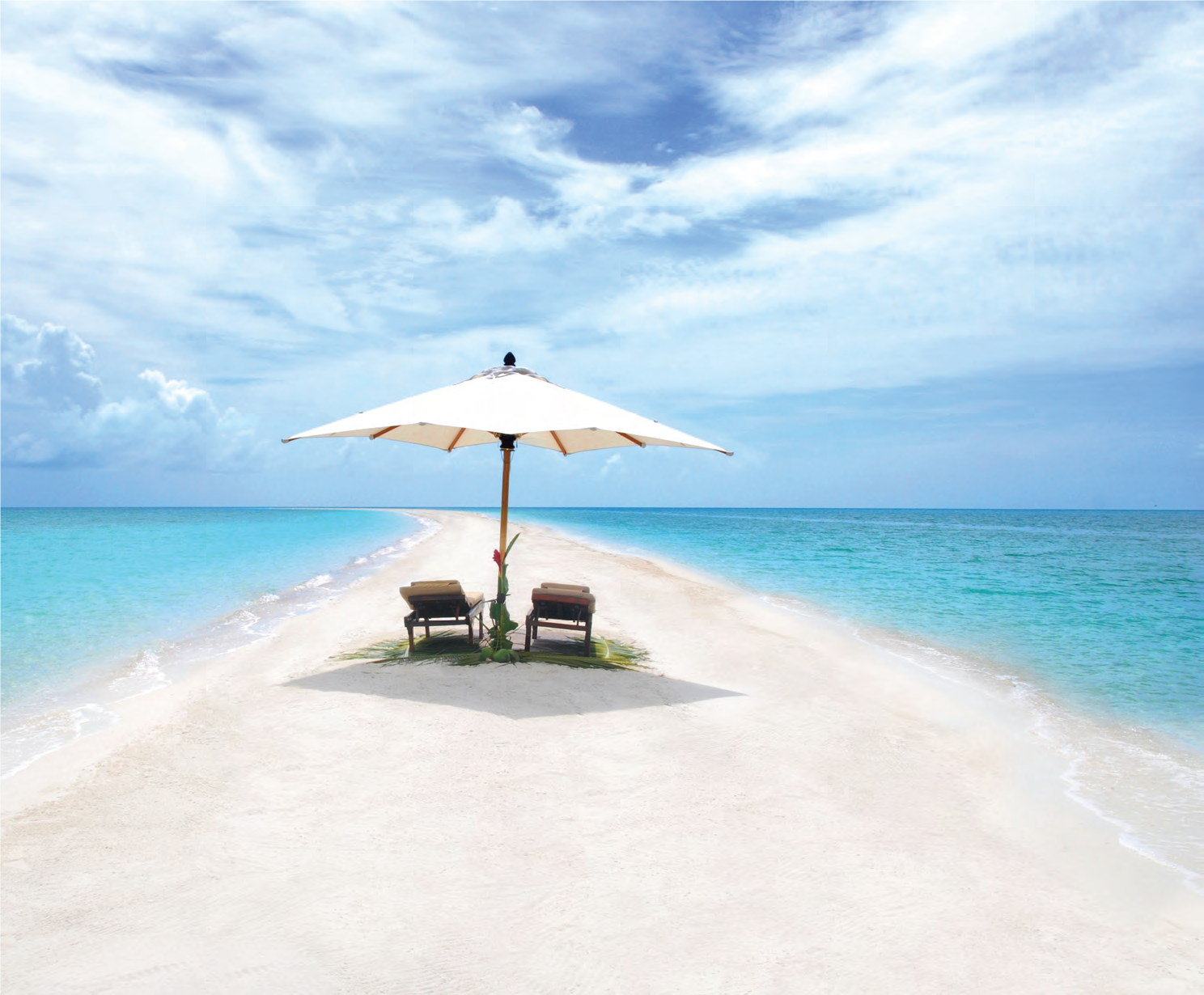
 aristocratic than in Cajun fare. Cajun food usually has a kick to it but, contrary to popular belief, an authentically prepared Cajun dish does not involve eye-watering heat. Unless, of course, you specifically ask for it that way. If you’ve been to New Orleans and still can’t remember which is which, Antoine’s is Creole and K-Paul’s (Paul Prudhomme) is Cajun. Emeril does both.
aristocratic than in Cajun fare. Cajun food usually has a kick to it but, contrary to popular belief, an authentically prepared Cajun dish does not involve eye-watering heat. Unless, of course, you specifically ask for it that way. If you’ve been to New Orleans and still can’t remember which is which, Antoine’s is Creole and K-Paul’s (Paul Prudhomme) is Cajun. Emeril does both.

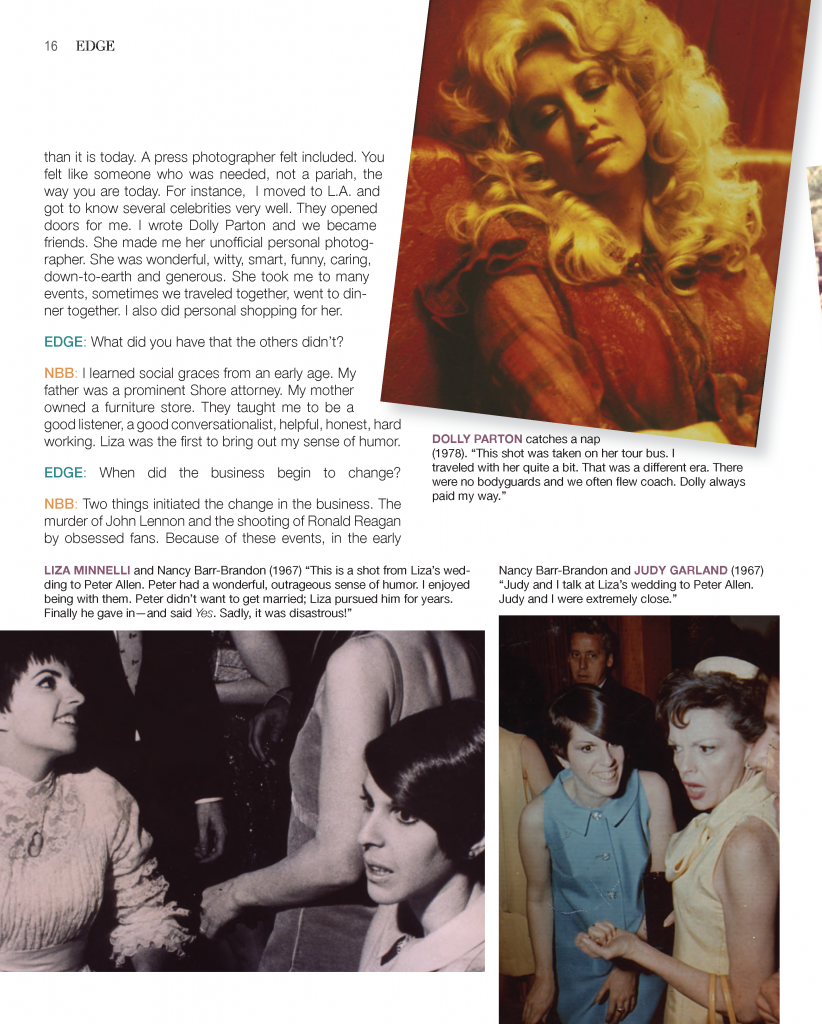
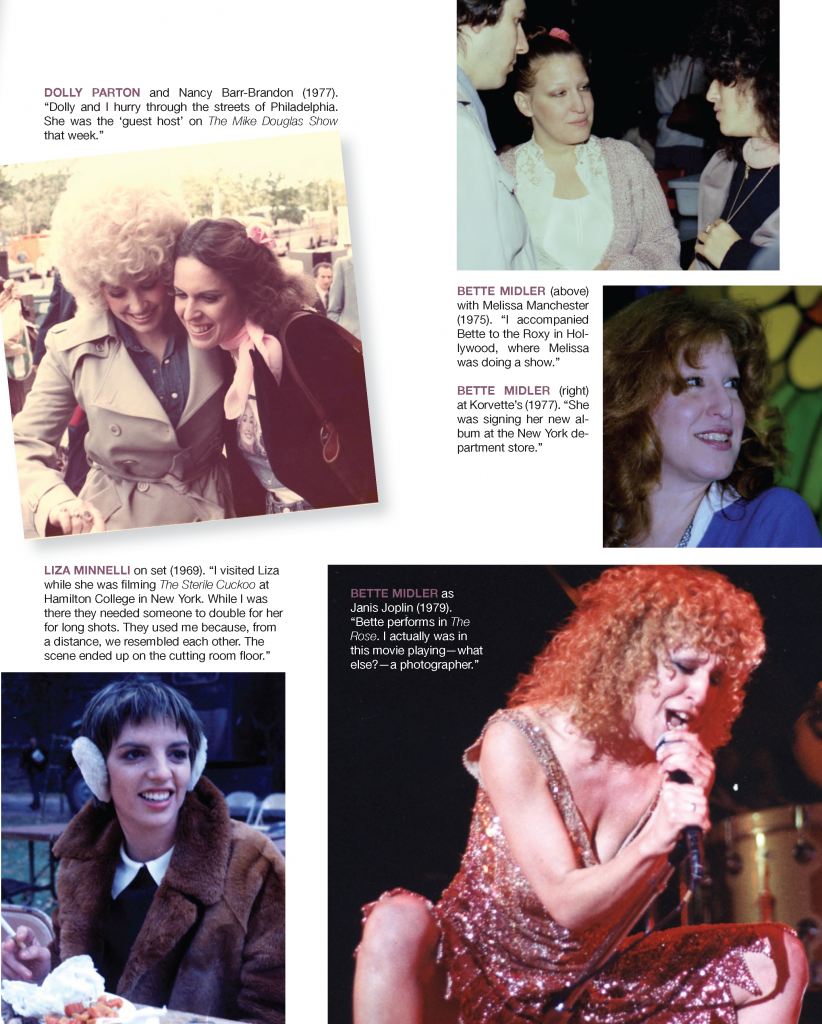

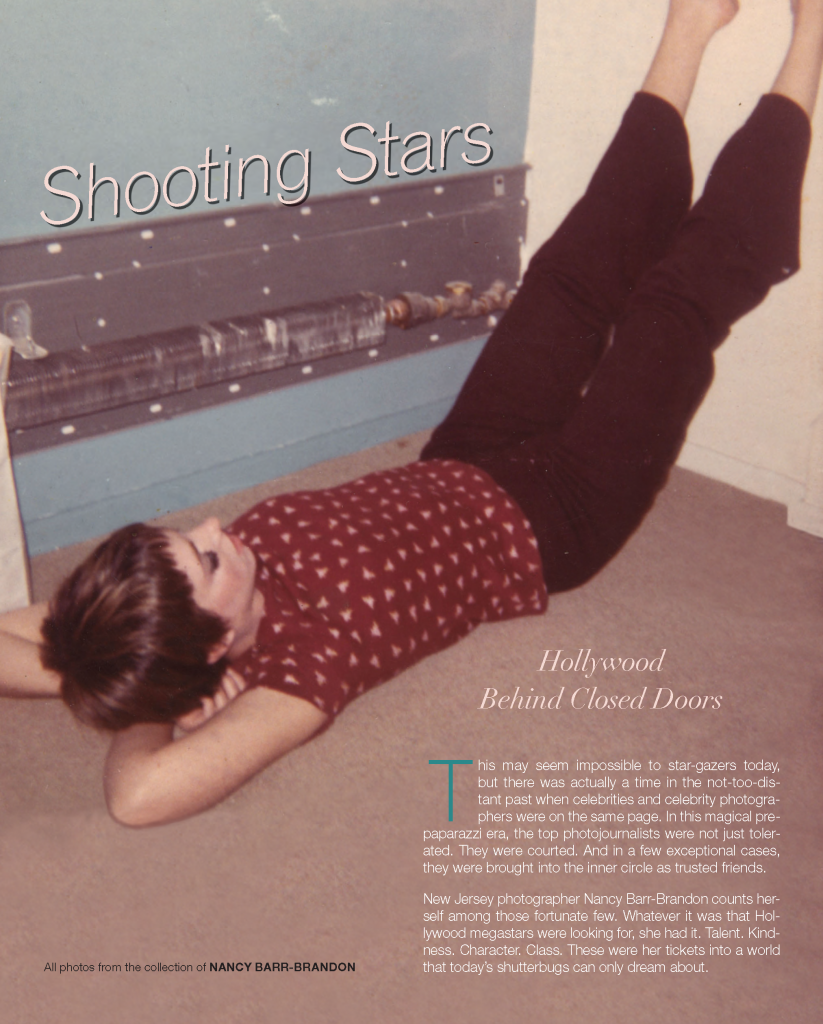

 caffeinated beverages, cigarettes, chocolate—can cause sleep problems. If the room isn’t dark enough, or if you leave a TV on, that can interfere with sleep. Engaging in some sort of stimulating activity, like an office conference, an argument or a workout, can make it hard to fall asleep.” Even something that’s often considered a sleep aid—we’re talking nightcap here—can backfire. “Alcohol may make you drowsy enough to fall asleep, but you’ll wake up again in a few hours,” explains Cheryl Krempa, RPh, MBA, Director of the Pharmacy at Trinitas.
caffeinated beverages, cigarettes, chocolate—can cause sleep problems. If the room isn’t dark enough, or if you leave a TV on, that can interfere with sleep. Engaging in some sort of stimulating activity, like an office conference, an argument or a workout, can make it hard to fall asleep.” Even something that’s often considered a sleep aid—we’re talking nightcap here—can backfire. “Alcohol may make you drowsy enough to fall asleep, but you’ll wake up again in a few hours,” explains Cheryl Krempa, RPh, MBA, Director of the Pharmacy at Trinitas.



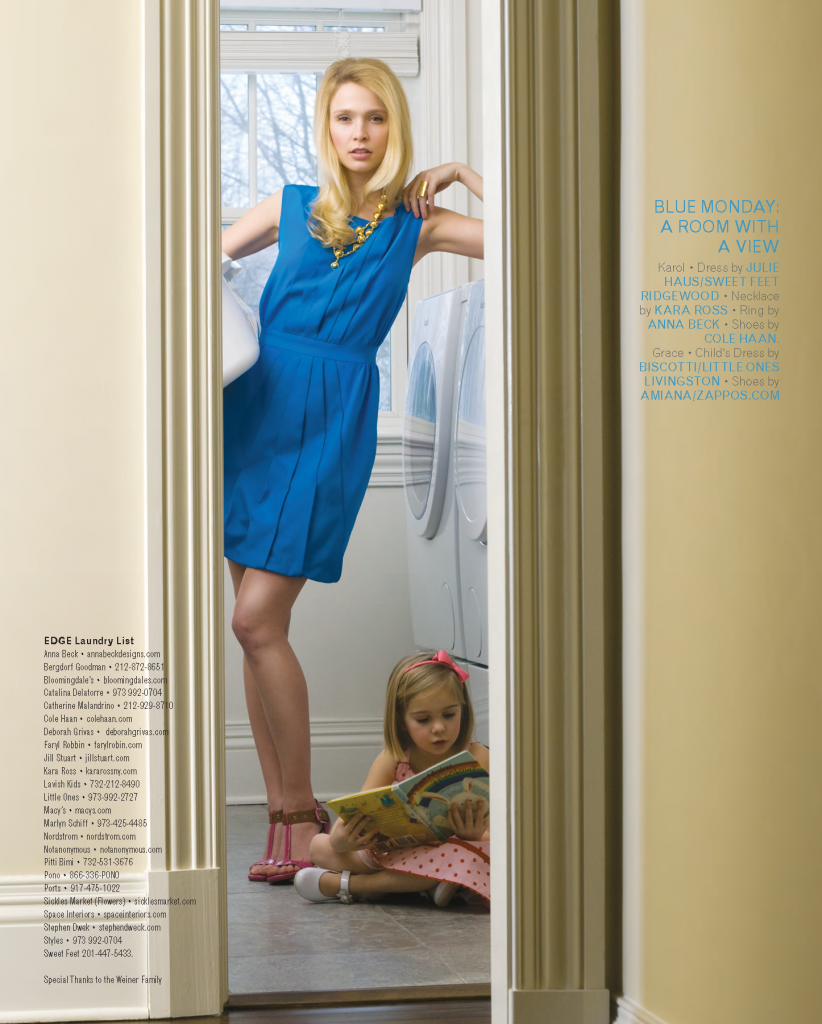


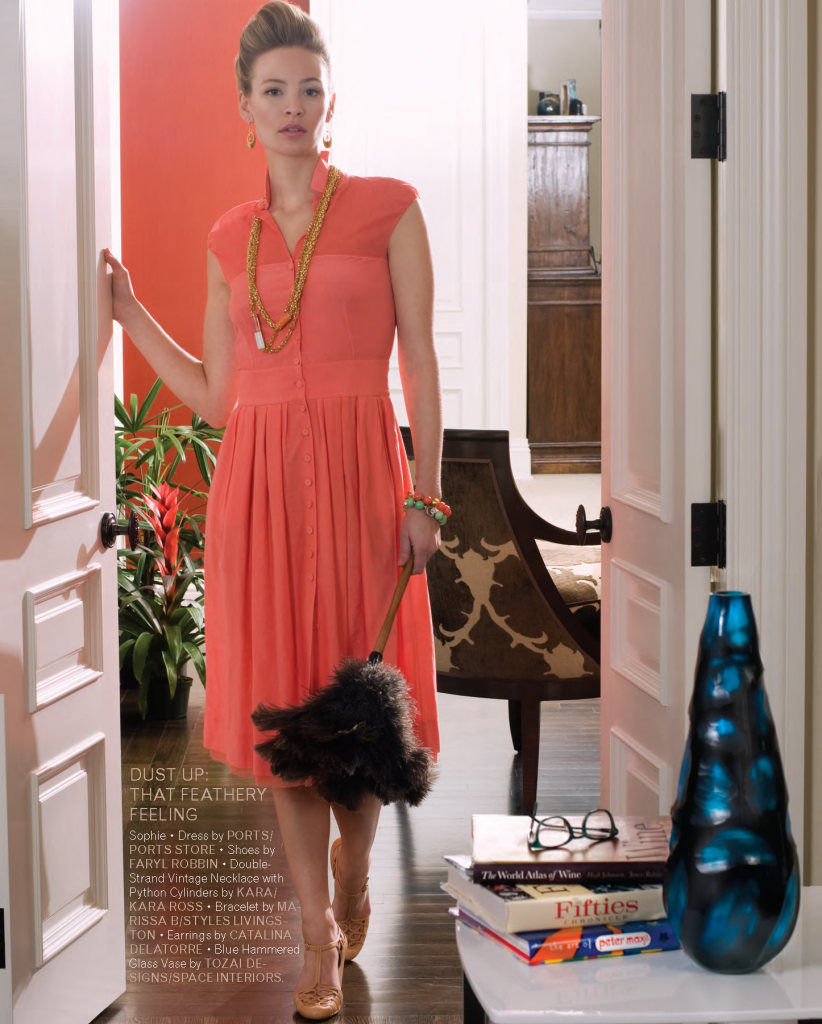







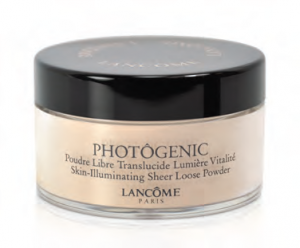 fire way to keep your face looking trim and contoured is to eliminate any shine. After shooting for eight hours in 103-degree, dense New Orleans heat, I found that DIOR’S BLOTTING PAPERS ($21) were a total and complete lifesaver.
fire way to keep your face looking trim and contoured is to eliminate any shine. After shooting for eight hours in 103-degree, dense New Orleans heat, I found that DIOR’S BLOTTING PAPERS ($21) were a total and complete lifesaver.




 ackpot is waiting at one of AC’s world-class spas, where skincare regimens play a major role in relieving the outward signs of stress—and the hotels leave little to chance. “We’re the newest spa in Atlantic City,” says Jane Mackie of the Chelsea Hotel’s Sea Spa. “The décor is retro—close to nature. There’s an opportunity to do natural and healthy treatments here.”
ackpot is waiting at one of AC’s world-class spas, where skincare regimens play a major role in relieving the outward signs of stress—and the hotels leave little to chance. “We’re the newest spa in Atlantic City,” says Jane Mackie of the Chelsea Hotel’s Sea Spa. “The décor is retro—close to nature. There’s an opportunity to do natural and healthy treatments here.” ray Organic Treatments, including the Body Renewal & Detoxification Therapy, Organic Firming Massage, and Organic Facial, utilize key ingredients in sea salts and seaweed, which rank among the purest form of therapeutic organic substances. Seibel also shares with clients his concerns regarding certain skincare products. “Many facial products may smell nice, but many people, whether they know it or not, may be allergic to them.” He recommends the Spa’s Organic Facial, noting that it works for those with sensitive skin and folks wanting “something different.” Every day you leave the house, you’re rolling the dice when it comes to the health of your skin. So how ironic is it that the one place you can’t lose is the gambling capital of the East? Just another reason to adore New Jersey.
ray Organic Treatments, including the Body Renewal & Detoxification Therapy, Organic Firming Massage, and Organic Facial, utilize key ingredients in sea salts and seaweed, which rank among the purest form of therapeutic organic substances. Seibel also shares with clients his concerns regarding certain skincare products. “Many facial products may smell nice, but many people, whether they know it or not, may be allergic to them.” He recommends the Spa’s Organic Facial, noting that it works for those with sensitive skin and folks wanting “something different.” Every day you leave the house, you’re rolling the dice when it comes to the health of your skin. So how ironic is it that the one place you can’t lose is the gambling capital of the East? Just another reason to adore New Jersey.


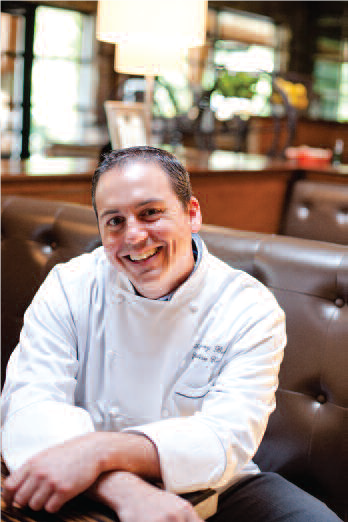 long commute to their new five-bedroom homes on two acres over for the day, there’s a smattering of casual dinner-seekers finishing burgers, there are journalists like me, in between night meetings, stopping in to catch the local gossip in a homey, low-key setting. That Ryland’s a roadhouse, a pitstop on the outskirts of suburbia. By the time it was purchased and re-imagined as a fine-dining destination, with Dennis Foy briefly installed as the name chef—a front man for then-little-known Craig Shelton—Readington and eastern Hunterdon had sprawled confidently into suburbia and many of the denizens in the immediate ‘hood (not to mention surrounding hunt country) were well-heeled and world-wise, ready for haute cuisine in an atmosphere to match, right in their backyards. The 1990s Ryland Inn delivered it all. Soon Shelton was on the cover of Gourmet magazine and the recipient of the food world’s equivalent of an Oscar, a James Beard Award. Ryland catered to the food cognoscente and captains of industry in a seamless operation that defied anything New Jersey had seen. Though its last years were rocky—and the flood that six years ago forced the inn to close was tragic—Ryland had made restaurant history in a state once better known for red sauce joints and boardwalk grub. The rebirth of the Ryland Inn a year ago, a vision realized by new owners Jeanne and Frank Cretella, with chef Anthony Bucco, gives us a very shiny new dining toy.
long commute to their new five-bedroom homes on two acres over for the day, there’s a smattering of casual dinner-seekers finishing burgers, there are journalists like me, in between night meetings, stopping in to catch the local gossip in a homey, low-key setting. That Ryland’s a roadhouse, a pitstop on the outskirts of suburbia. By the time it was purchased and re-imagined as a fine-dining destination, with Dennis Foy briefly installed as the name chef—a front man for then-little-known Craig Shelton—Readington and eastern Hunterdon had sprawled confidently into suburbia and many of the denizens in the immediate ‘hood (not to mention surrounding hunt country) were well-heeled and world-wise, ready for haute cuisine in an atmosphere to match, right in their backyards. The 1990s Ryland Inn delivered it all. Soon Shelton was on the cover of Gourmet magazine and the recipient of the food world’s equivalent of an Oscar, a James Beard Award. Ryland catered to the food cognoscente and captains of industry in a seamless operation that defied anything New Jersey had seen. Though its last years were rocky—and the flood that six years ago forced the inn to close was tragic—Ryland had made restaurant history in a state once better known for red sauce joints and boardwalk grub. The rebirth of the Ryland Inn a year ago, a vision realized by new owners Jeanne and Frank Cretella, with chef Anthony Bucco, gives us a very shiny new dining toy.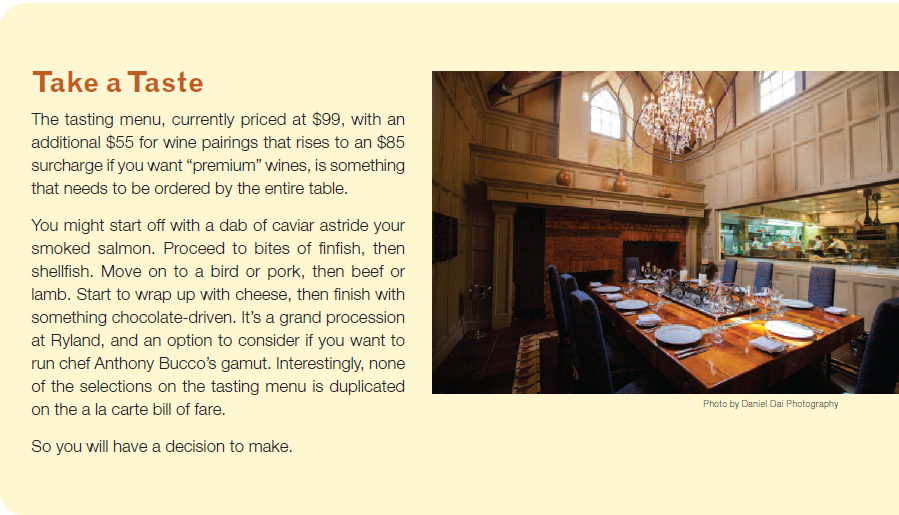 The outdoor entryway that leads to the indoor entryway just about shouts “Have your wedding here!” Once inside, vaulted ceilings, chandeliers that look like they were recycled from Liz Taylor’s diamond booty, fabrics and appointments hardly from the off-the-rack collections, and an air of mission accomplished set the scene for rarefied dining. Rather than a pretty charger plate that will be swept away shortly after you’re seated, there’s a framed picture at your place setting. Something old to add to all the new, I suspect. The Cretellas clearly wanted to bring every aspect of Ryland’s past to its high-toned present, and so there’s a sense of history in the artwork as well as in the Old-World graciousness of the well-orchestrated service. Come to Ryland to be pampered, once again.
The outdoor entryway that leads to the indoor entryway just about shouts “Have your wedding here!” Once inside, vaulted ceilings, chandeliers that look like they were recycled from Liz Taylor’s diamond booty, fabrics and appointments hardly from the off-the-rack collections, and an air of mission accomplished set the scene for rarefied dining. Rather than a pretty charger plate that will be swept away shortly after you’re seated, there’s a framed picture at your place setting. Something old to add to all the new, I suspect. The Cretellas clearly wanted to bring every aspect of Ryland’s past to its high-toned present, and so there’s a sense of history in the artwork as well as in the Old-World graciousness of the well-orchestrated service. Come to Ryland to be pampered, once again.
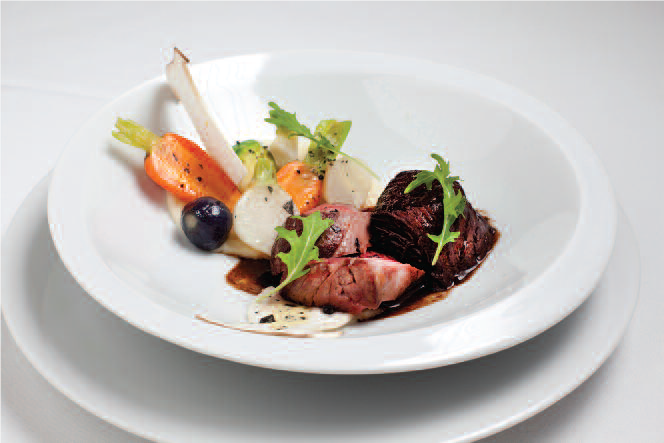


 NJIT Cafeteria Garden • Newark Installed in 2010 by “My Local Gardener” with Peter Fischbach and Julie Aiello You can’t get fresher or healthier food than the vegetables that are served at NJIT’s cafeteria. For three years, NJIT students and faculty have enjoyed farm-to-table vegetables harvested from an elevated 220 sq. ft. organic roof garden outside the student pub. On an existing “green” roof—which already had a faucet—the design team installed 10 recycled flower boxes and filled them with a light soil that wouldn’t weigh down the roof. According to NJIT chef Peter Fischbach (right), who envisioned the project with Julie Aiello, Director of Marketing and Sustainability for Gourmet Dining Services (GDS), the campus food purveyor, they plant rotating crops of healthy vegetables four to five times a growing season, including lettuce, beets, tomatoes, squash, broccoli, kale, collard greens, Brussels sprouts, peppers and peas. They also grow a large selection of herbs, which are used to season the food. Meanwhile, the garden has germinated other campus organic gardens. According to Fischbach, “The project has been so successful that it has inspired other colleges serviced by GDS—Seton Hall, Manhattan College, Kean University, FDU in Madison. And we are preparing to put in a garden at Bloomfield College.”
NJIT Cafeteria Garden • Newark Installed in 2010 by “My Local Gardener” with Peter Fischbach and Julie Aiello You can’t get fresher or healthier food than the vegetables that are served at NJIT’s cafeteria. For three years, NJIT students and faculty have enjoyed farm-to-table vegetables harvested from an elevated 220 sq. ft. organic roof garden outside the student pub. On an existing “green” roof—which already had a faucet—the design team installed 10 recycled flower boxes and filled them with a light soil that wouldn’t weigh down the roof. According to NJIT chef Peter Fischbach (right), who envisioned the project with Julie Aiello, Director of Marketing and Sustainability for Gourmet Dining Services (GDS), the campus food purveyor, they plant rotating crops of healthy vegetables four to five times a growing season, including lettuce, beets, tomatoes, squash, broccoli, kale, collard greens, Brussels sprouts, peppers and peas. They also grow a large selection of herbs, which are used to season the food. Meanwhile, the garden has germinated other campus organic gardens. According to Fischbach, “The project has been so successful that it has inspired other colleges serviced by GDS—Seton Hall, Manhattan College, Kean University, FDU in Madison. And we are preparing to put in a garden at Bloomfield College.”

 uld also be able to tell you with absolute certainty whether you can get the job done without tearing out your first-floor ceilings. This greatly reduces the mess and expense. From a builder’s perspective, adding a second story isn’t all that different than building from the ground up.
uld also be able to tell you with absolute certainty whether you can get the job done without tearing out your first-floor ceilings. This greatly reduces the mess and expense. From a builder’s perspective, adding a second story isn’t all that different than building from the ground up. ou should also think about pulling together the interior. Indeed, a less common but still-critical mistake homeowners make is failing to really think through how the new second story will relate to the “new” first story in terms of how the entire home is used. Moving bedrooms to the second floor opens up all sorts of possibilities on the main level. If you determine how you might be using the first-floor space in the future, you can leave yourself a lot of options, especially if a new kitchen is part of the long-term plan. When it’s all said and done, a basic second-story addition will eat up a half-year of your life and cost you at least $125 to $150 per square foot, soup-to-nuts, plus professional fees. Depending on your desired finishes and a handful of other variables, the price tag of a 1,000-foot addition is likely to be in the neighborhood of $150,000. Does that make sense in your neighborhood? Ultimately, that’s a call you’ll have to make.
ou should also think about pulling together the interior. Indeed, a less common but still-critical mistake homeowners make is failing to really think through how the new second story will relate to the “new” first story in terms of how the entire home is used. Moving bedrooms to the second floor opens up all sorts of possibilities on the main level. If you determine how you might be using the first-floor space in the future, you can leave yourself a lot of options, especially if a new kitchen is part of the long-term plan. When it’s all said and done, a basic second-story addition will eat up a half-year of your life and cost you at least $125 to $150 per square foot, soup-to-nuts, plus professional fees. Depending on your desired finishes and a handful of other variables, the price tag of a 1,000-foot addition is likely to be in the neighborhood of $150,000. Does that make sense in your neighborhood? Ultimately, that’s a call you’ll have to make.




 arrangements are made. For those who cannot (or will not) leave home to participate in a study, Dr. Garg proposes an alternative possibility: an at-home sleep study, using a new portable device that collects the same useful data. Success stories are hardly few and far between at Trinitas Comprehensive Sleep Disorders Center. On the contrary, the center conducted nearly 1,500 studies in 2012, including adults and children. One of Dr. Garg’s favorite stories concerns an eight-year-old boy, who was prescribed ADHD medication after meeting with a psychiatrist and pediatrician for hyperactivity and inattention in school.
arrangements are made. For those who cannot (or will not) leave home to participate in a study, Dr. Garg proposes an alternative possibility: an at-home sleep study, using a new portable device that collects the same useful data. Success stories are hardly few and far between at Trinitas Comprehensive Sleep Disorders Center. On the contrary, the center conducted nearly 1,500 studies in 2012, including adults and children. One of Dr. Garg’s favorite stories concerns an eight-year-old boy, who was prescribed ADHD medication after meeting with a psychiatrist and pediatrician for hyperactivity and inattention in school.
 sure you are on-track to reach your goals.
sure you are on-track to reach your goals.
 Editor’s Note: Gerontologist Alexis Abramson, PhD appears frequently as an on-air expert for NBC’s Today show, and also on CNN, CBS and MSNBC. Her commitment to baby boomers and mature adults has been featured in TIME, Forbes, The Wall Street Journal, People and other national publications. To see more of her thoughts on aging gracefully (and intelligently), log onto alexisabramson.com.
Editor’s Note: Gerontologist Alexis Abramson, PhD appears frequently as an on-air expert for NBC’s Today show, and also on CNN, CBS and MSNBC. Her commitment to baby boomers and mature adults has been featured in TIME, Forbes, The Wall Street Journal, People and other national publications. To see more of her thoughts on aging gracefully (and intelligently), log onto alexisabramson.com.
 Flip-Flopping in the Classroom The back-to-school season always holds some surprises for educators, kids and parents. This year, many noticed a rise in foot pain among returning students. The popularity of cheap, stylish flip-flops has more than a little to do with this, according to the American College of Foot and Ankle Surgeons. Right into the mid-teens, kids have new bone growing in their heels. Flip-flops offer no support or cushioning for this part of the foot, and summer-long repetitive stress can manifest itself in pain and injuries once students switch back to traditional school footwear. If your child is experiencing pain, it’s important to explore an immediate remedy—stretching exercises, ice massage, anti-inflammatory medications, and custom or over-the-counter shoe inserts are certainly worth exploring. Obviously, if the pain worsens or persists, a visit to the podiatrist is called for.
Flip-Flopping in the Classroom The back-to-school season always holds some surprises for educators, kids and parents. This year, many noticed a rise in foot pain among returning students. The popularity of cheap, stylish flip-flops has more than a little to do with this, according to the American College of Foot and Ankle Surgeons. Right into the mid-teens, kids have new bone growing in their heels. Flip-flops offer no support or cushioning for this part of the foot, and summer-long repetitive stress can manifest itself in pain and injuries once students switch back to traditional school footwear. If your child is experiencing pain, it’s important to explore an immediate remedy—stretching exercises, ice massage, anti-inflammatory medications, and custom or over-the-counter shoe inserts are certainly worth exploring. Obviously, if the pain worsens or persists, a visit to the podiatrist is called for. Follow-Up on NYC Soda Ban New York’s short-lived soda ban spurred a slew of studies on the actual impact of obesity-focused legislation. A recent article published in the American Journal of Agricultural Economics suggests that strategies such as taxing sugary beverages would not reduce obesity, because consumers would simply switch to un-taxed options. Public health advocates have posited that higher prices would deter unhealthy food purchases. But according to research economists, that simply isn’t the case. In New York, a court ruled that the Board of Health exceeded its authority in instituting the ban, which was pushed by Mayor Michael Bloomberg. Among the criticisms of an “obesity tax” is that it would target lower-income consumers who tend to buy more high-calorie foods and beverages, and thus would be a regressive tax. Even so, the search for a “social solution” will continue; more than a third of U.S. adults, and one in six children, are technically obese. The medical costs associated with obesity are between $125 and $150 billion a year.
Follow-Up on NYC Soda Ban New York’s short-lived soda ban spurred a slew of studies on the actual impact of obesity-focused legislation. A recent article published in the American Journal of Agricultural Economics suggests that strategies such as taxing sugary beverages would not reduce obesity, because consumers would simply switch to un-taxed options. Public health advocates have posited that higher prices would deter unhealthy food purchases. But according to research economists, that simply isn’t the case. In New York, a court ruled that the Board of Health exceeded its authority in instituting the ban, which was pushed by Mayor Michael Bloomberg. Among the criticisms of an “obesity tax” is that it would target lower-income consumers who tend to buy more high-calorie foods and beverages, and thus would be a regressive tax. Even so, the search for a “social solution” will continue; more than a third of U.S. adults, and one in six children, are technically obese. The medical costs associated with obesity are between $125 and $150 billion a year. Drug Wonder Downunder A pair of Australian medical researchers have been recognized for their breakthrough work with Duchenne Muscular Dystrophy, a condition caused by mutations in the dystrophin gene on the X chromosome—which means it mostly affects boys. DMD patients are wheelchair-dependent by age 12 and often don’t survive past their early 20s. The researchers have developed a drug that works by skipping over the faulty part of the gene, producing a functional version of the protein dystrophin. This protein stabilizes the muscle fiber during muscle contraction. Without dystrophin, muscle fibers are replaced by scar tissue. In clinical trials, boys on the drugs have been walking up hills, operating pedal cars and whistling after 90 weeks. “It is extremely exciting to see that genetic testing is finally coming to the forefront of clinical medicine,” says Dr. Kevin Lukenda, Chairman of TRMC’s Family Medicine Department. “For years, this information was limited to research and academia. With a simple swab of a patient’s saliva in my office, we can detect over 30 possible genetic mutations within an individual’s DNA. This is the future of early diagnoses and treatment in clinical medicine.”
Drug Wonder Downunder A pair of Australian medical researchers have been recognized for their breakthrough work with Duchenne Muscular Dystrophy, a condition caused by mutations in the dystrophin gene on the X chromosome—which means it mostly affects boys. DMD patients are wheelchair-dependent by age 12 and often don’t survive past their early 20s. The researchers have developed a drug that works by skipping over the faulty part of the gene, producing a functional version of the protein dystrophin. This protein stabilizes the muscle fiber during muscle contraction. Without dystrophin, muscle fibers are replaced by scar tissue. In clinical trials, boys on the drugs have been walking up hills, operating pedal cars and whistling after 90 weeks. “It is extremely exciting to see that genetic testing is finally coming to the forefront of clinical medicine,” says Dr. Kevin Lukenda, Chairman of TRMC’s Family Medicine Department. “For years, this information was limited to research and academia. With a simple swab of a patient’s saliva in my office, we can detect over 30 possible genetic mutations within an individual’s DNA. This is the future of early diagnoses and treatment in clinical medicine.” You Snooze, You Lose Don’t lose sleep over junk food purchases. Seriously, don’t. A new study shows that lack of sleep can lead people to buy more food—and more high-calorie items— when they shop. Researchers gave 14 normal-weight men a budget of $50 and instructed them to purchase as much as they could out of a possible 40 food items, which included 20 high-calorie and 20 low-calorie foods. They conducted this exercise after a night of sleep deprivation and again after a good night’s sleep. They bought 18 percent more food— and 9 percent more calories—after a night of sleep deprivation. “Another recent study showed tha
You Snooze, You Lose Don’t lose sleep over junk food purchases. Seriously, don’t. A new study shows that lack of sleep can lead people to buy more food—and more high-calorie items— when they shop. Researchers gave 14 normal-weight men a budget of $50 and instructed them to purchase as much as they could out of a possible 40 food items, which included 20 high-calorie and 20 low-calorie foods. They conducted this exercise after a night of sleep deprivation and again after a good night’s sleep. They bought 18 percent more food— and 9 percent more calories—after a night of sleep deprivation. “Another recent study showed tha t the pleasure centers of the brain were activated more when sleep-deprived people looked at pictures of junk food,” adds Dr. Vipin Garg, Director of the Trinitas Comprehensive Sleep Disorders Center. “Lack of sleep can prevent the brain from making an intelligent decision regarding healthy food choices. Getting enough quality sleep can help weight control by allowing people to make proper nutritional decisions and also provide energy to exercise to achieve better overall health.” There are plans in the works for follow-up studies to see how sleep deprivation affects other buying decisions.
t the pleasure centers of the brain were activated more when sleep-deprived people looked at pictures of junk food,” adds Dr. Vipin Garg, Director of the Trinitas Comprehensive Sleep Disorders Center. “Lack of sleep can prevent the brain from making an intelligent decision regarding healthy food choices. Getting enough quality sleep can help weight control by allowing people to make proper nutritional decisions and also provide energy to exercise to achieve better overall health.” There are plans in the works for follow-up studies to see how sleep deprivation affects other buying decisions. Word of Mouth Unreliable Where Strokes are Concerned So what’s the deal with the “Crooked Tongue” story making the rounds on social media? According to countless emails and Facebook postings, a woman who was suffering from a stroke but didn’t exhibit the typical symptoms was diagnosed by an alert ER physician who asked her to stick out her tongue. When she did so, and her tongue presented to one side rather than straight out, he was able to correctly diagnose the stroke and save his patient’s life. Is the “crooked tongue” technique a reliable way to diagnose stroke? According to Dr. John D’Angelo, Chairman of Trinitas Regional Medical Center’s Emergency Department, the story has all the earmarks of an urban legend. “I can find no reference to this suggestion from any reliable source, such as the Heart and Stroke Foundation, the American Heart Association or the National Institute of Neurological Disorders and Stroke,” he says. “Lingual deviation can indicate a host of issues that are typically associated with a tumor or other type of lesion. So a crooked tongue is a sign that something is wrong, but it’s not a reliable sign you are having a stroke.” The T in the American Stroke Assoc
Word of Mouth Unreliable Where Strokes are Concerned So what’s the deal with the “Crooked Tongue” story making the rounds on social media? According to countless emails and Facebook postings, a woman who was suffering from a stroke but didn’t exhibit the typical symptoms was diagnosed by an alert ER physician who asked her to stick out her tongue. When she did so, and her tongue presented to one side rather than straight out, he was able to correctly diagnose the stroke and save his patient’s life. Is the “crooked tongue” technique a reliable way to diagnose stroke? According to Dr. John D’Angelo, Chairman of Trinitas Regional Medical Center’s Emergency Department, the story has all the earmarks of an urban legend. “I can find no reference to this suggestion from any reliable source, such as the Heart and Stroke Foundation, the American Heart Association or the National Institute of Neurological Disorders and Stroke,” he says. “Lingual deviation can indicate a host of issues that are typically associated with a tumor or other type of lesion. So a crooked tongue is a sign that something is wrong, but it’s not a reliable sign you are having a stroke.” The T in the American Stroke Assoc
 promise for a more effective treatment of Type 2 Diabetes, which currently affects more than 25 million Americans. In the Harvard study, Belatrophin caused mice to produce insulin-secreting pancreatic beta cells at up to 30 times the normal rate. The new cells produce insulin only when called upon by the body. This offers the potential for natural regulation of insulin, as well as a reduction in the complications associated with diabetes. There is hope that this treatment may also have an impact on juvenile diabetes. It could eventually mean that instead of taking insulin injections three times a day, you might take an injection of this hormone once a week or once a month or—in the best case—maybe even once a year, explains Doug Melton, one of the researchers. “This new hormone offers optimism for researchers lo
promise for a more effective treatment of Type 2 Diabetes, which currently affects more than 25 million Americans. In the Harvard study, Belatrophin caused mice to produce insulin-secreting pancreatic beta cells at up to 30 times the normal rate. The new cells produce insulin only when called upon by the body. This offers the potential for natural regulation of insulin, as well as a reduction in the complications associated with diabetes. There is hope that this treatment may also have an impact on juvenile diabetes. It could eventually mean that instead of taking insulin injections three times a day, you might take an injection of this hormone once a week or once a month or—in the best case—maybe even once a year, explains Doug Melton, one of the researchers. “This new hormone offers optimism for researchers lo
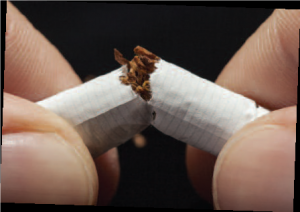 University of Oregon’s Department of Psychology, learning meditation techniques makes it easier for smokers to taper off. Mindful Meditation—a technique that encourages people to relax, focus on the current moment and “go with the flow” of thoughts and sensation—has already been shown to have a positive impact on cold and flu, hot flashes and irritable bowel syndrome. In the Oregon study, 60 people received five hours of either relaxation training or Mindful Meditation training. Among the smokers in the study, there was no difference in the amount the relaxation group smoked. However, the smokers in the meditation group had cut back by 60 percent. Researchers admit that the smoking findings are surprising, and caution that the study was very small. Also, the participants were all college students. On the other hand, none of the subjects were told they were taking part in a smoking study. And the Oregon study found that the brains of the smokers who learned meditation techniques were more active in an area linked to self-control. More work in this area is warranted.
University of Oregon’s Department of Psychology, learning meditation techniques makes it easier for smokers to taper off. Mindful Meditation—a technique that encourages people to relax, focus on the current moment and “go with the flow” of thoughts and sensation—has already been shown to have a positive impact on cold and flu, hot flashes and irritable bowel syndrome. In the Oregon study, 60 people received five hours of either relaxation training or Mindful Meditation training. Among the smokers in the study, there was no difference in the amount the relaxation group smoked. However, the smokers in the meditation group had cut back by 60 percent. Researchers admit that the smoking findings are surprising, and caution that the study was very small. Also, the participants were all college students. On the other hand, none of the subjects were told they were taking part in a smoking study. And the Oregon study found that the brains of the smokers who learned meditation techniques were more active in an area linked to self-control. More work in this area is warranted.









